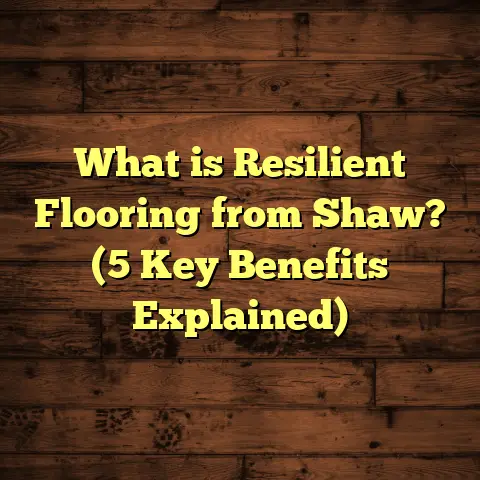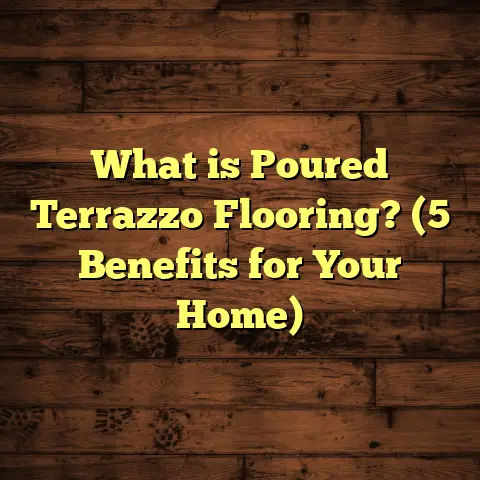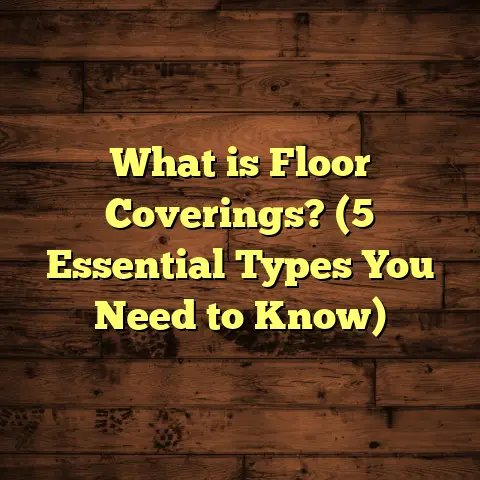What is Pergo Laminate Flooring? (5 Remarkable Benefits Revealed)
Warmth—there’s something about it that instantly makes a house feel like a home. Whether it’s the cozy glow from a fireplace or the comforting touch of a soft rug beneath your feet, warmth adds a layer of comfort that goes beyond temperature. When I think about flooring, warmth plays a huge role in how a space feels. The right floor can make a room inviting, cozy, and welcoming. But it’s not just about looks or feel; practical considerations like durability, ease of maintenance, and cost are equally important.
That’s why I want to talk about Pergo laminate flooring today because it offers a unique combination of warmth, style, and practicality that I’ve come to really appreciate through my years working in the flooring business. I’ve installed Pergo floors in all kinds of homes—from busy family kitchens to stylish living rooms—and I’ve learned a lot about what makes this product stand out.
If you’ve ever wondered whether Pergo laminate flooring is right for your home, or if you’re curious about what it really is and how it performs, this article will give you everything you need to know—from technical details to real-life experiences.
What is Pergo Laminate Flooring?
Let me start by breaking down exactly what Pergo laminate flooring is. You might have heard of Pergo as a brand name before. In fact, Pergo was the first company to introduce laminate flooring back in the 1970s. Over time, the brand became so popular that many people use “Pergo” to refer to laminate flooring in general, kind of like how some say “Kleenex” for any tissue.
But technically speaking, Pergo laminate flooring is a type of flooring made from multiple layers fused together to create a durable surface that looks like wood or stone but costs less and requires less maintenance.
Here’s how it’s constructed:
- Wear layer: This is the very top layer that protects your floor against scratches, stains, fading from sunlight, and everyday wear and tear. Pergo uses advanced protective coatings such as WearGuard Plus that make this layer extremely tough.
- Design layer: Just below the wear layer is an ultra high-resolution photographic print that mimics the look of real wood grain or stone patterns. This gives Pergo floors their authentic appearance.
- Core layer: This is typically made from high-density fiberboard (HDF) or sometimes medium-density fiberboard (MDF). It provides structural stability and strength to the floorboard.
- Backing layer: The bottom layer adds moisture resistance and balances the board so it doesn’t warp or bend.
What makes Pergo laminate different from other laminates is its patented technology in wear layers and edge sealing, which improves durability and water resistance.
Now you might be asking: why should I consider laminate when hardwood floors have always been considered the “gold standard” for warmth and beauty?
That’s a great question. Hardwood floors are undeniably beautiful, but they come with drawbacks—they can scratch easily, dent under heavy furniture or pets, are expensive to install, and require ongoing maintenance like refinishing.
Pergo laminate flooring bridges the gap by offering a warm wood-look floor that’s more affordable, easier to maintain, and resistant to damage while still providing a cozy feel underfoot.
1. Durability That Lasts: Built for Everyday Life
One of the biggest reasons I recommend Pergo laminate flooring to homeowners is its outstanding durability. This isn’t just marketing hype—I’ve seen it firsthand on countless job sites.
Pergo was actually one of the pioneers in creating laminate floors tough enough to withstand heavy foot traffic, pets, kids, and everything else life throws at your floors.
What Makes Pergo So Durable?
The secret lies in their WearGuard Plus technology—a specially engineered top layer that provides superior resistance to scratches, stains, fading, and scuffs.
According to independent tests conducted by flooring industry labs:
- Pergo’s wear layer offers up to 4 times better scratch resistance than typical laminate floors.
- It also shows excellent resistance to impact damage from dropped objects.
- The UV-resistant coating prevents color fading even in sunny rooms.
To put this into perspective, I once installed Pergo laminate in a home with two large dogs who loved running around indoors. After nearly two years of daily roughhousing, the floors still looked fresh without any visible scratches or wear marks.
That kind of toughness isn’t common with traditional hardwood floors—especially if you’re dealing with active kids or pets.
Real-World Case Study: Family Life with Pergo
A family I worked with recently had been struggling with their old hardwood floors that constantly showed scratches from their children’s toys and pet claws. They switched to Pergo laminate flooring in their living room and kitchen.
After 18 months, they reported the floors still looked brand new despite heavy use. The mom told me she no longer felt anxious when her kids played indoors or when guests walked in with shoes on. For them, durability meant peace of mind.
2. Easy Installation — Save Time and Money
Another reason I’m a big fan of Pergo is how easy it is to install. Whether you’re hiring a pro or doing it yourself, this can save time and reduce overall project costs.
How Does Installation Work?
Pergo laminate uses a floating click-lock system that allows planks to snap together tightly without nails or glue. This means installation can be completed much faster than traditional hardwood floors that require nailing or stapling down each board.
From my experience:
- Installation time can be reduced by 30-40% compared to hardwood.
- There’s less room for mistakes since you don’t have to worry about aligning nails or adhesive.
- You can install over many existing subfloors like concrete or plywood as long as they’re level and clean.
I helped a client who wanted to redo her basement rec room flooring by herself. She was nervous at first but found the click-lock system very forgiving. She finished the entire room over a weekend without any professional help.
This ease of installation also means less downtime for your home renovation project—important if you want your space back quickly.
Installation Tips from My Experience
- Always lay down an underlayment beneath Pergo laminate—it helps absorb sound and adds comfort underfoot.
- Acclimate the planks in the room for 48 hours before installation to prevent expansion or contraction after installation.
- Leave small expansion gaps around walls (usually 1/4 inch) so the floor can expand slightly with temperature changes.
- Use spacers during installation to maintain consistent gaps.
3. Affordable Style Without Sacrificing Quality
One of the things that surprised me when I first started recommending Pergo laminate was how realistic it looks compared to hardwood floors.
You might think laminate means cheap-looking plastic surfaces. That’s no longer true—Pergo has pushed the boundaries with high-definition printing and texture embossing techniques that recreate even fine wood grain details.
Authentic Textures That Feel Real
Pergo’s Authentic Texture finish creates subtle grooves and patterns that you can actually feel beneath your feet. This adds depth and dimension missing from older laminates that looked flat or fake.
They also offer a wide variety of styles—from rustic oak to dark walnut to modern gray tones—so you can find something that matches your home decor perfectly.
Cost Comparison
Here’s something worth noting: Pergo laminate flooring is significantly more budget-friendly than hardwood but doesn’t compromise on looks or performance.
| Flooring Type | Material Cost per sq ft | Average Installation Cost per sq ft | Total Cost Range per sq ft |
|---|---|---|---|
| Pergo Laminate Flooring | $2 – $5 | $1 – $3 | $3 – $8 |
| Hardwood Flooring | $6 – $12 | $3 – $5 | $9 – $17 |
| Luxury Vinyl Plank | $2 – $7 | $1 – $3 | $3 – $10 |
This means you can achieve a warm wood look throughout your home without breaking your budget—especially if you want to cover larger areas like living rooms or open-plan spaces.
4. Easy Maintenance for Busy Homes
Here’s where Pergo laminate flooring really shines for families like mine who need durable yet low-maintenance solutions.
Unlike hardwood that needs periodic refinishing and special cleaners, laminate floors require very little upkeep.
Simple Cleaning Routine
Since Pergo laminate has a tough wear layer, spills don’t soak into the boards easily. That means:
- A quick sweep or vacuum keeps away dust.
- Damp mopping with mild soap removes dirt without damaging the surface.
- No waxing or polishing needed.
- Stains like coffee or juice wipe right off if cleaned promptly.
I always advise clients with kids or pets that this easy maintenance saves hours of worry each week. For example, one friend with three young children told me she loves her Pergo floors because she can let her kids play freely without stressing about spills ruining the floor.
Resisting Common Household Hazards
Because of its protective coating:
- Pergo resists stains from wine, pet accidents, food spills.
- It holds up well against scratches from pets’ nails or moving furniture.
- The surface doesn’t fade under sunlight exposure as quickly as traditional wood finishes.
5. Better Resistance to Moisture Than You’d Expect
One common question I get is whether laminate flooring is suitable for kitchens, bathrooms, or basements where moisture is more likely.
Traditional laminates are sensitive to water—prolonged exposure causes swelling and warping—but Pergo has improved this with technologies like Hydroseal edge sealing.
What Is Hydroseal?
Hydroseal is a special coating applied on plank edges during manufacturing that blocks water from seeping in between boards. This makes Pergo more water-resistant than many other laminates on the market.
While not completely waterproof like vinyl or tile, these features make Pergo suitable for:
- Kitchens
- Laundry rooms
- Basements (with proper moisture control)
- Entryways where wet shoes may track water
In one basement project I managed where humidity levels fluctuated seasonally, Pergo held up well over several years without signs of swelling or delamination—as long as spills were cleaned quickly.
That said, standing water should never sit on any wood-based flooring for long periods. Proper ventilation and humidity control still matter.
Deep Dive Into Product Lines: Which Pergo Is Right for You?
Pergo offers several product lines tailored for different needs—from budget-conscious options to premium lines designed for heavy commercial use.
Here’s a quick overview based on what I’ve learned:
| Product Line | Key Features | Best Use Case |
|---|---|---|
| Pergo Outlast+ | High scratch & stain resistance; water-resistant edges | Busy family homes; kitchens |
| Pergo TimberCraft | Realistic textures; moderate water resistance | Living rooms; bedrooms |
| Pergo Extreme | Commercial-grade durability; enhanced water resistance | Offices; retail spaces |
| Pergo Sensation | Embossed texture; lower price point | Budget projects; rentals |
Choosing the right product depends on your household lifestyle (kids? pets?), expected foot traffic, moisture level in rooms, and budget constraints.
What About Environmental Impact?
I know many homeowners care about sustainability today. You’ll be happy to know that Pergo laminate incorporates environmentally friendly practices like:
- Using recycled wood fibers in core layers
- Low VOC (volatile organic compound) emissions for healthier indoor air quality
- Certifications such as FloorScore® ensuring compliance with strict indoor air standards
If you want eco-conscious flooring that doesn’t sacrifice looks or durability, this is another point in favor of Pergo.
How Does Pergo Compare Against Other Flooring Options?
I often get asked how Pergo stacks up against other popular choices like engineered hardwood, vinyl plank, or tile. Let me share some insights based on my hands-on experience and industry data:
Compared to Engineered Hardwood
- Engineered hardwood has real wood veneer on top but can be pricey.
- It requires more maintenance (polishing/refinishing) than laminate.
- Not as scratch-resistant—can dent easier.
- Looks authentic but costs more upfront.
Compared to Luxury Vinyl Plank (LVP)
- LVP is fully waterproof and great for wet areas.
- It can feel softer underfoot but sometimes looks less natural than high-end laminate.
- LVP can be pricier depending on quality.
Compared to Ceramic Tile
- Tile is very durable and waterproof but cold/hard underfoot.
- Installation is labor-intensive and costly.
- Tiles can crack if heavy objects drop on them.
If you want warmth (both visually and physically), durability, ease of care, and affordability—Pergo laminate hits a sweet spot many homeowners appreciate.
Personal Stories: Why I Keep Recommending Pergo
I’ll share a few stories from my work over the years that helped me see just how versatile and reliable Pergo laminate flooring is:
Story 1: The Busy Family Kitchen Rescue
A client called me desperate because their kitchen hardwood floor was scratched beyond repair after only one year with three kids running around. We removed the damaged floor and installed Pergo Outlast+ instead. Six years later, no scratches or dents showed up despite heavy use—and they loved how easy cleanup was after messy cooking sessions.
Story 2: DIY Success in a Small Apartment
My cousin wanted new floors but couldn’t afford professional installation. I recommended Pergo TimberCraft because it was affordable and easy for beginners. She installed it herself over two days and was thrilled with how natural it looked. She said it transformed her apartment without spending a fortune or waiting weeks for installers.
Story 3: Basement Game Room Makeover
In my own home basement renovation project, I chose Pergo Extreme for its water resistance since basements tend to have occasional humidity issues. It has held up perfectly through winters and summers without warping or discoloration.
Final Thoughts on Choosing Flooring That Feels Like Home
Choosing the right flooring isn’t just about aesthetics—it’s about creating an environment where you feel comfortable every day. With my experience installing hundreds of floors over many years, I’ve seen how important it is to get both style and substance right.
If you want warm-looking floors that are tough enough for real life—whether you’ve got kids chasing balls indoors or pets running around—Pergo laminate flooring delivers across multiple fronts:
- Durability that stands up against scratches
- Easy installation saving time and money
- Affordable price without sacrificing style
- Low maintenance ideal for busy households
- Water resistance suitable for many rooms
I hope sharing my knowledge helps you make an informed choice for your home. If you have questions about specific styles or installation tips—or want help estimating costs—just reach out! Flooring decisions are big ones but choosing right brings years of comfort underfoot.
Thanks for spending this time learning about Pergo laminate flooring with me—I’m confident it could be exactly what your home needs right now.





